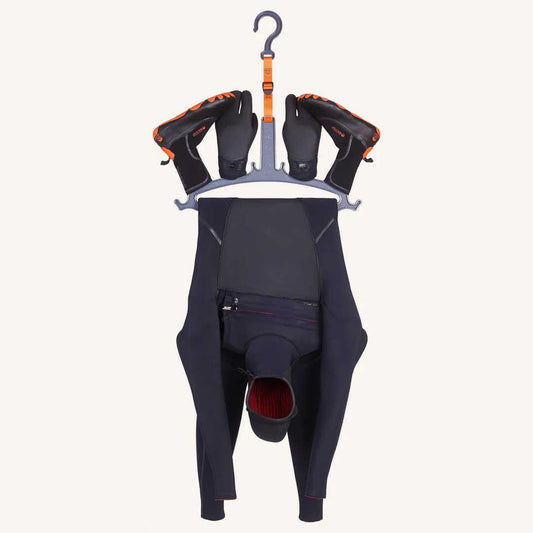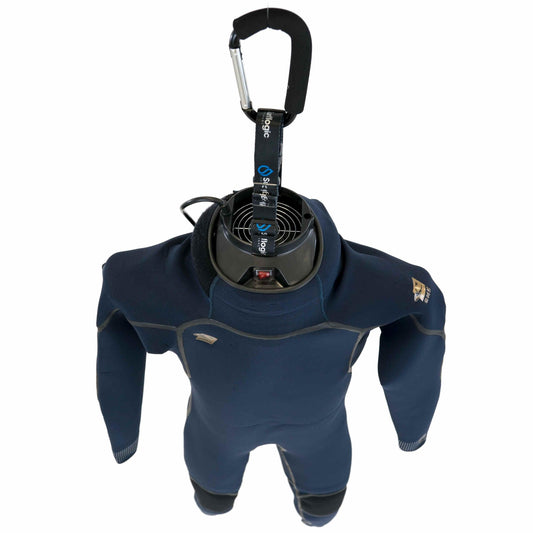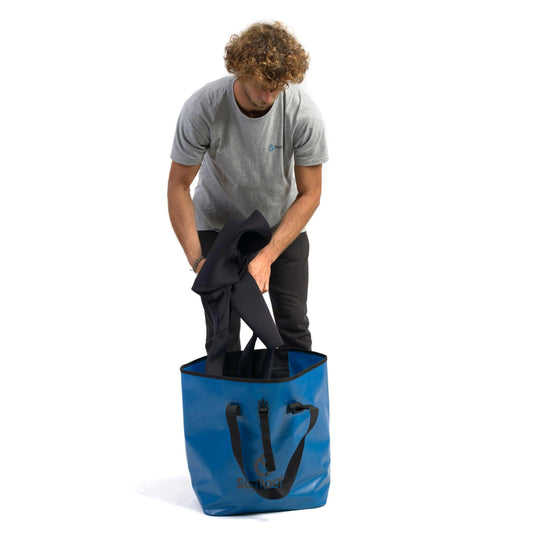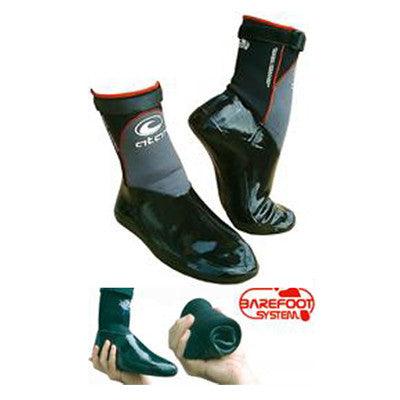How to Layer Up for Winter Watersports | Poole Harbour Watersports
India HudsonShare
Winter Watersports Survival Guide: Accessories to Keep You Warm
For those who brave the winter waters, layering becomes the key to an unforgettable experience instead of a freezing struggle. Buying a winter wetsuit, either 4 or 5mm thick, doesn’t mean you still won’t feel the cold, and instead of getting a thicker or warmer wetsuit, you can instead layer up and accessorise for a comfortable session on the water. Layering means that the cold air temperature doesn’t cool you down as much, and it can add more thermal and neoprene layers so that you stay warmer when in the cold water.
You may think, why not just buy a warmer or thicker wetsuit? Well, if you have a three-season suit (4mm) and this works well for you most the year round, it may just be those few session out in February and March where you really feel the cold. In this instance, instead of a whole new wetsuit you would only wear a couple of times, layers and accessories are a more cost-effective and long-term solution.
It doesn’t just have to be the answer for if you have a 4mm wetsuit, some people may still feel the cold in a 5mm thick wetsuit and you may want to layer up as it can all depend on your conditions and how you feel the cold.
The Base Layer – Thermal Rash Vests
Thermal rash vests act as a base layer, primarily underneath a wetsuit (but you can wear just as a top layer too) as it adds an extra layer of insulation. Made from poly-fleece and lycra, thermal rash vests trap a thin layer of water between the skin and the vest, which your body warms up, creating insulation against cold water that can enter your wetsuit or when the neoprene cools down from the wind chill. The fleece lining of the rash vest provides not only warmth, but a soft comforting feel under the suit and around the neck where you can get chafing, whilst not restricting movement as thinner and more flexible than neoprene.

As with any rash vest, you want it to be snug and tight to the skin, as this will maximise the warmth to the surface of your skin. As such they will look small before you try it on, but a good fit will be one that clings to your body to prevent any water flushing through.
Some people want maximum warmth with a long sleeve rash vest which you can browse below:
O'Neill Thermo Long Sleeve Mens Rash Vest
O'Neill Thermo Long Sleeve Womens Rash Vest
While others want just added layering on their main torso and so go for short sleeve as can be more comfortable under a thicker wetsuit. Browse our options below:
C-Skins Thermal Skins Mens Short Sleeve
C-Skins Thermal Skins Womens Short Sleeve
C-Skins Thermal Skins Junior Short Sleeve
Top-Layer – Hooded Jackets
Neoprene hoodies are oversized jackets, with or without a zip, that go on top of your wetsuit (and harness to if you are wearing it as they have a harness hole too) and provide an extra layer of warmth as they act as a barrier to the wind and water hitting your wetsuit and then your skin.

The neoprene material provides insulation for the torso, arms, and head, retaining body heat even when wet, making it effective for cold-weather water activities. The neoprene material is also highly effective at blocking wind chill and resisting water onto your wetsuit, so it’s particularly useful in breezy or splash-prone environments like kitesurfing or windsurfing when your body can cool down outside the water.
The attached hood protects your head and neck from cold water and wind, preventing rapid heat loss, which commonly happens through the head and neck area too, as well as sheltering too if it is a rainy session.

These hooded jackets are a great layer to those that find that they cool down quickly and are after more of an external barrier to keep warm in the winter water conditions. You also can wear it in milder seasons such a spring as a jacket over a swimsuit or thinner wetsuit for wind protection too even when paddleboarding, sailing etc.
Check out a few options we have below:
Mystic Voltage Sweat 3mm Hoodie
Protecting Your Extremities – Hoods, Gloves, and Boots
Your extremities, the head, hands, and feet are areas where we lose heat quickly due to high blood flow near the surface of the skin. In cold water, this heat loss is amplified, potentially leading to hypothermia if these areas aren't properly protected.
Up to 50% of body heat can be lost through an unprotected head, so wearing a hood or cap is essential to stay warm!

Cold extremities can lead to discomfort and premature fatigue, cutting water activities short. Protecting your extremities with neoprene or other insulating materials keeps you more comfortable, allowing for longer, more enjoyable sessions.
Fingers - Gloves/ Mittens
Cold water rapidly reduces sensation and control in your hands and feet, making it difficult to grip or steer equipment, such as paddles, boards, booms and bars, definitely not ideal during your session.

Neoprene gloves and mittens provide insulation, allowing you to retain movement and grip even in cold water, which is essential for safety and effective performance.
Mittens can be popular for those not needing any finger movement, such as swimmers, windsurfers and some kitesurfers. Mittens can also be warmer for your hands as your fingers are altogether in the neoprene.
Check out some popular mitten options below:
Windsurfers/ Kitesurfers - ION Open Palm Mitten
Swimmers/ Surfers - Alder Plasma Mitten
Head - Hoods/ Hats
Keeping the heat in from your head can make for a totally different experience on the water as you lose around 50% heat from your head!
If you are to be submerged in the water most of the time (surfing, swimming or even windsurfing) then a hood that encompasses your whole head, ears and neck is a great way to stay warm and keep the heat in and cold wind chill off.
Sometimes a little extra layer is just needed for your head when kitesurfing, windsurfing, sailing or winging as it is more of a wind chill aspect that you want to protect your head from. As such, neoprene beanies are becoming increasingly popular as they keep your head and ears warm, but are more comfortable and less encompassing than a hood, plus they fit comfortably under a helmet as well!

We also find cold-water dippers/ swimmers vouch for these beanie hats as they want to keep the heat in while they are dipping, and a neoprene one is better as it is waterproof!
Take a look at a couple of our popular options below:
C-Skins Storm Chaser Neo Beanie
O'Neill Psycho Hood
C-Skins Legend Hood
Feet - Boots
Your feet and first in and last out of the water, and as such they are going to get cold first! Your toes also don't move around too much as you are either swimming, standing or in footstraps, so they need protecting from the wind and cold water with some toasty 3-5mm boots!
Not only do wetsuit boots allow to keep your feet warm by trapping a thin layer of water between your skin and the neoprene material, insulating your feet and preventing heat loss; they also protect your feet from rough surfaces and objects. During the colder season the surfaces can also be icy, rubber soles are designed on wetsuit boots to provide better grip on slippery or wet surfaces, useful when walking on wet rocks or getting in and out of the water on slick surfaces.
Boots are an essential for anyone going in the water from November-March, as without them it can actually be so painful on your feet in the water.
We find that zipped boots especially are popular in winter as they are easier to take on and off, when your hands and body are cold and numb, the zip is super useful!
Check out a few of our best-selling booties:

We also sell lots of neoprene socks to swimmers in winter, these are around 3-4mm thick, so keep your feet nice and warm, but do not have a rubber sole so easier to put on but also lighter for when you want to kick your legs in the sea.
Check out our neoprene socks below:
Alder Impact 3mm socks
Alder Burn 4mm socks
|
One last layer that may be important to keep warm before and after your session is a dryrobe! This can help maintain your core temperature when out in the cold winds or weather on land, and ensure that you do not get any colder! Shop the extensive range here - Dryrobe Advance. |
 |
In conclusion, to stay warm during the cold winter months, they are many routes and layers you can add to your wetsuit. It is super important you try to keep as warm as possible in the cold waters as it will ensure you have a great session on the water but also that you do not catch any colds or hypothermia!
If you want to try out any of these layer options, we have them all in-store in Poole, or you can browse online and ask us for any more questions too!










